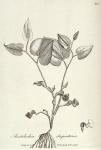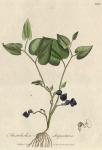
 Also see 107. Aristolochia longa. Long-rooted Birthwort.
Also see 107. Aristolochia longa. Long-rooted Birthwort.
Synonyma. Serpentaria virginiana. Pharm. Lond. & Edinb.
Aristolochia Pistolochia s. Serpentaria virginiana, cause nodoso. Pluk. Alm. 50. p. 148. Catesby Hist. of Carol. t. 1. p. 29. tab. 29. Raii Hist. vol. iii. p. 394.
Aristolochia polyrrhizos virginiana, &c. Morris. Hist. iii. p. 310. Park. Theat. p. 420.
Class Gynandria. Ord. Hexandria. Lin. Gen. Plant. 1022.
Ess. Gen. Ch. Hexagyna. Cal. o. Cor. 1-petala, lingulata, integra. Caps, 6-locularis, infera.
Spec. Char. A. fol. cordato-oblongis planis, caulibus infirmis flexuosis teretibus, flor solitariis. Caulis geniculata valde nodosa. Flores ad radicem.
The root is perennial, and composed of a number of small fibres, proceeding from a common trunk; externally brown, and internally whitish: the stems are slender, round, crooked, jointed, and rise about eight or ten inches in height: the leaves are heart-shaped, entire, pointed, veined, and stand upon strong footstalks, to which they are attached by three prominent ribs: it has no calyx: the flowers are monopetalous, solitary, of a purplish brown colour, and placed upon long sheathed jointed peduncles, which rise from the lower articulations of the stem: the corolla is tubular, irregular; at the base distended into a globular figure, at the middle contracted and twisted, at the extremity spreading, and of a triangular form: it has no filaments, but six anthers, which are attached to the under side of the stigma: the germen is oblong, angular, and placed below the corolla: the style is extremely short: the stigma is roundish, and divided into six parts: the capsule is hexagonal, separated into six cells, which contain several small flat seeds. It is a native of Virginia, and flowers in August.
The first account we have of Serpentaria is that given in Johnson's edition of Gerard, in which we are told that it was brought from Virginia, and grew in the garden of Mr. John Tradescant, of South Lambeth, in 1632. But Johnson evidently confounds the Serpentaria with the Pistolochia cretica of Clusius. In 1635, Dr. J. Cornutus published at Paris, Canadensium plantarum, aliarumque nondum editarum, Historia, wherein the Serpentaria is noticed under the name of Radix Snagroel Nothae Angliae, and highly extolled as an effectual remedy for the bites of the most poisonous serpents. ["Missa quoque est ad me ex notha Anglia radix quam Serpentariae vocant, vernacule Snagroel cum hac inscriptione. Haec radix alexiterium praesentissimum est, contra morsum serpentis ingentis pernitiosissimique in notha Anglia, cujus morsus intra duodecim horas interficit, nisi hujus radicis sumatur portio, qua sumpta nullus unquam auditus est periclitari de vita." p. 214.]
Plukenet, whose botanical knowledge of this plant will not be doubted, informed Dale, that the roots of three different species of Aristolochia were sent to Europe for those of snake-root; ["Tres radices sub hoc nomine in officinis nostris veniunt, ut nos monuit eruditissimus ille Botanicus Leonard Plukenetius, M. D. in literis ad me datis, viz. 1. Aristolochia polyrrhizos, auriculatis foliis Virginiana. Pluk. Phytog. Tab. 78. Almag. 50. Tourn. Inst. 162. &c. 2. Aristolochia Violae fruticosae foliis Virginiana, cujus radix Serpentaria dicitur. Pluk. Phytog. T. 15. Almag. 50. &c. 3. Aristolochia Pistolochia, seu Serpentaria Virginiana, caule nodoso." This last is the plant we have figured. See Dale, Pharmacol. p. 194.] but though this might have happened a century ago, at present the practice appears to be no longer continued, for we have carefully examined several parcels of snake-root, without discovering these roots intermixed with those of the others referred to by Dale. We may notice however, that among these roots, some specimens of the whole plant were found, which differed from the annexed figure, having lance-shaped leaves. And this variety of Serpentaria seems to accord with that noticed by Alston, who says, "the dried specimen I have of the whole plant, brought directly from America by Mr. Richard Lightbody, surgeon, agrees with none of them; (meaning the three mentioned by Dale) the leaves no way resembling a heart at the footstalk, being there all roundish, or obtusely pointed." [M. M. vol. i. p. 521.] The plant, from which the present figure was designed, is now growing in the Royal Botanic Garden at Kew, where it was introduced by Mr.William Young about the year 1770. [We had this information from Mr. Aiton, who desires us to say, that, by mistake, this plant was passed unnoticed in the Hort. Kew.]
"Snake-root has an aromatic smell, approaching to that of valerian, but more agreeable, and a warm bitterish pungent taste, which is not easily concealed or overpowered by a large admixture of other materials. It gives out its active matter both to water and rectified spirit, and tinges the former of a deep brown, the latter of an orange colour. Greatest part of its smell and flavour is carried off in evaporation or distillation by both menstrua: along with water there arises, if the quantity of the root submitted to the operation be large, a small portion of pale-coloured essential oil, of a considerable smell, but no very strong taste, greatest part of the camphorated pungency, as well as bitterness of the root, remaining in the inspissated extract. The spirituous extract is stronger than the watery: not so much from its having lost less in the evaporation, as from its containing the active parts of the root concentrated into a smaller volume; its quantity amounting only to about one-half of that of the other." [Lewis, M. M. p. 602.]
The root, as we have already observed, was first recommended as a medicine of extraordinary power in counteracting the poisonous effects of the bites of serpents, and it has since been much employed in fevers, particularly those of the malignant kind: a practice which seems founded on a supposition that the morbific matter of these fevers is somewhat analogous to the poison of serpents, and that its influence upon the human system might be obviated by the same means: hence Serpentaria has been considered the most powerful of those medicine; termed alexipharmics. Modern physicians however have exploded this theory of antidotes, and the alexiterials and theriacas so industriously studied ever since the first ages of Greece, are now wholly disregarded.
Serpentaria is thought to possess tonic and antiseptic virtues, and is generally admitted to be a powerful stimulant and diaphoretic; and in some fevers where these effects are required, both this and contrayerva have been found very useful medicines, as abundantly appears from the experience of Huxham, Pringle, Hillary, Lysons, and others: yet it may be remarked, that by some of these authors this root has been employed too indiscriminately, for there seems to us some inconsistency in the practice of bleeding and giving snakeroot in the same fever.
It is thought by many, that peruvian bark and wine may in every case supersede the use of Serpentaria; [In cases marked with progressive signs of debility and putridity, there cannot be a doubt but that the bark, wine, and a suitable application of cold, are the remedies chiefly to be trusted; but by admitting this, we are not to reject Serpentaria as utterly useless in all fevers.] but this opinion is also liable to exceptions, as a mixed state of fever has been frequently observed to prevail, in which the bark has proved hurtful, though this root has evidently had a good effect; and even in intermittent fevers the bark has been found more efficacious when joined with Serpentaria than when given alone; [Vide Lysons, Practical Essays upon intermitting fevers, p. 13. Seq.] and this has been also the case in continued fevers. The dose of snake-root is usually from ten to thirty grains in substance, and to a dram or two in infusion. A tinctura serpentariae is directed both in the London and Edinburgh Pharmacopoeias.

